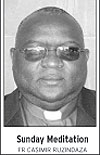When Jesus was about to depart from his disciples, he gave them one of the most beautiful gift that a man can have. He told them: “Peace I bequeath to you, my own peace I give you, a peace which the world cannot give, this is my gift to you.


When Jesus was about to depart from his disciples, he gave them one of the most beautiful gift that a man can have.
He told them: "Peace I bequeath to you, my own peace I give you, a peace which the world cannot give, this is my gift to you. Do not let your hearts be troubled or afraid.” (Jn 14:27) We find this in our liturgy of the sixth Sunday of Easter.
Jesus was right because if his desciples’ faith would be tried and their peace of mind is troubled, their capacity to remember and to teach what he had told them would be very low. Since they carried on well their work, there is no doubt that the peace he gave them helped a lot.
According to Blaise Pascal in his Pensées, this was a great gift because all people at all times have suffered the pains of boredom, self-doubt, loneliness, irritability, restlessness, and anxiety that come from not being at peace with themselves.
And to the present day we all do experience our fair share of that. According to Blaise pascal, this lack of peace of mind and heart is the root cause of man’s most problems: "All of man’s misfortune comes from one thing, which is not knowing how to sit quietly in a room”
But why did Jesus give priority to peace, given the many needs that his disciples had? Was it perhaps to prove the old saying that ‘with wealth one can live in comfort, with drive one can make a comfortable living but with peace of mind, one can be comfortable in living!
Definitely, Jesus had thought of the situation in which his disciples were going to work; in which what they would need most would be ‘his peace’. He knew that lack of peace and restlessness are part of our human nature.
Jesus teaches us a great lesson in our modern time. We all feel a kind of thirst at the core of our being, a dissatisfaction that drives us to find meaning, happiness and peace.
But all too often we don’t actually move in the direction where we find these essential commodities.
We just get moving; at times without enough self-awareness and we are inclined simply to find some distraction. With different kinds of distractions, we may fill our lives with empty busyness.
That way, feeling temporarily released from our thirst; though what really happens is less awareness that we are still suffering.
Being at peace is a condition of success in its highest and noblest form. And Jesus wanted his disciples to keep that wonderful state of mind and body where all is calm.
This would keep their thoughts quiet and serene through all the persecution they had to undergo, remembering that they were together hence keeping their muscles relaxed and comfortable in all their suffering.
We can understand this from our own experience. Once we are adept at controlling our mind and body; we feel we are at the wheel and self driving, hence with the courage to drive on, regardless of how slippery the road ahead may be! This can be possible because peace of mind does not come from outside but from within ourselves.
An individual learning from his or her experience may conclude that being at peace is a matter of choice. It comes when we stop struggling and fighting the world around us and the world within us and relate to both in a way that allows peace to happen.
Myrtle Reed puts it in a better way: Every time you borrow trouble you give your peace of mind as security.
Jesus’ gift of peace to his disciples teaches us a great lesson today on the importance of peace of mind. We must do all we can to stop the fights that go on within ourselves in order to create room for peace of mind.
Our individual fight may be within our thoughts, emotions and physical bodies. We must therefore find ways to quickly give up the fight and win at the same time.
The first step would involve our constant awareness of what we are doing. The second step would be to consciously make the choice to release the tension. The next step is to hold images that encourage a peaceful mind.
And lastly, let us learn from prayerful and meditative people who have managed to control their mind by holding steady mental pictures. For thousands of years now, this method has been successful.
Ends


